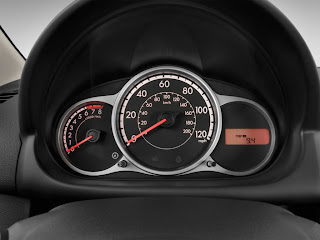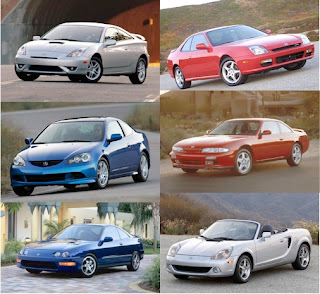Before going any further, I just want to define what I'm considering old and new here. Old will be pretty much anything you buy used from a private seller. This rules out any certified pre-owned stuff, and covers everything from carburetion to fuel-injection, since any era of used car can have issues over the years. New will be anything that comes straight off the lot, never ending up in the hands of anyone else except for dealer test drives.
| Photo: http://www.4starsigns.com/ |
So let's start off with older cars. The first and most prominent advantage is starting price. This is the big thing that is so attractive to car buyers and is what many used and old car proponents will go to first in a debate whether to buy new or old. Admittedly, it's a very, VERY strong argument. Ever wanted to be driving a German luxury sedan? You can do so for less than a stripped out Hyundai Accent. Really, the options are near limitless on what kind of car you can get for the money, depending on how old you want to go, and what kind of condition you want. Many a sports car, luxury car, or premium SUV can be had for drastically lower costs than a similar new vehicle if you don't mind the car being around five years old or so.
So the up front price is really low, is there a catch? Well, there might be. If you've ever owned a car or known someone that has owned a car, you know problems do come up. They can be anything from simple wear items like needing new tires or it's due for a timing belt change, or it can be something more serious or unexpected. Maybe the car was abused and neglected (owner went 20,000 miles between oil changes or something) and there are serious engine problems. Being thorough about your test drive, having the prospective car inspected by a mechanic, and doing anything you can to research potential problems are all things that you can do to help avoid many of these possible problems, but it's still possible to miss something or have something go wrong that was already fine. For instance, the stereo amplifier in my brother's Mini Cooper just recently decided to die, rendering any attempt to listen to music hopeless until the amp is replaced, or a boombox is added to the interior.
| Photo: http://www.kevingerard.com/1986Porsche928Red.htm |
There are of course other things like not having the latest in gadgetry (lately I've been jealous of iPod integration in newer cars) or not being as quiet or refined, or just being in rough shape all around. Despite all this, an older car can be pretty great.
When you avoid the really bad cars and find yourself just the right car at just the right price, life can be cool. If it's in good shape, has a good reliability history, and has all the right features without paying through the nose, few things can compare. Plus, saving that money can go to other things that you like or want to do, whether it's with your car, or other activities.
Moving on to new cars, there are quite a few things that they do have an advantage when compared with used cars, but buying new still isn't a magic bullet.
One of the big ways new cars are wonderful is that you're the only one to have used it. Only in the double digit mileage range, a new car has never been in the hands of anyone else except for brief test drives and whoever delivered it. Everything is clean, everything is shiny, and everything works. Not a single thing is wrong with it. It's a car as perfect as freshly fallen snow. And that new car smell! Although that new car smell is apparently various plastics outgassing into the interior, it smells so incredibly good; intoxicating might be a little too perfect a word....
| Photo: www.bbc.co.uk/newsbeat/11071047 |
And not having anything wrong with the car is pretty great too. Think about it, you would be able to drive off in a car, and the only thing you have to worry about is taking it easy driving it during the break-in period. That's it. Nothing is going to break, nothing is going to fail, it's all good. Just cruise and enjoy yourself until your first oil change. Sure there's the chance that you might hit something and damage something, or there might be a recall for fiery death, but there's no chance of shoddy repairs or neglectful owners from the past. Just the proper specs and assembly from the factory. And even in the event of some problems or recalls, there's a warranty to help out.
So a new car sounds perfect right? Well, no still not perfect. First thing is the up front cost. Unlike a used car, a new car is going to cost you. For $15k, all you're really going to be able to afford on the new market is a subcompact like a Honda Fit, a Ford Fiesta, a Mazda2, et al. Not that any of those cars are bad mind you, it's just that they aren't necessarily... aspirational automobiles. For the same $15k, you could pick up say, a Honda S2000 (9000 rpm redline, rear wheel drive, convertible top, superb handling) and have a much more impressive car.
The warranty isn't perfect either. It only lasts for so long, and it doesn't necessarily cover everything that could happen to your car, just certain things. Plus, if you want to go in and modify your car, just know that the nice long warranty you had just packed it's bags and ran away. Oh and we shouldn't forget depreciation. The second you sign your papers and leave the lot, you just lost a few grand, and it's not going to stop.
But, if you're willing to deal with some of these things, the comfort and reassurance of having a fresh car with no issues can be very nice. Plus having the latest in amenities and refinements mean that you have a very modern and comfortable car to cruise around in.
Basically, with cars, old or new, it's pick your poison/pleasure. There simply is no magic bullet. You're going to lose out somewhere, and you're going to win out somewhere. The important thing here is, you can prioritize, and through these options, you can max out your priorities and minimize your compromise. You're looking for a sports car on a budget and you don't mind fixing a few niggles or issues? The used market is ready for you. You need a family hauler with the latest in technology and can't worry about it breaking down? There's a slew of new cars waiting for you. Old and new cars are both great, and despite their setbacks, you can rest assured that there's one (or two, or three, or more) out there for you.






